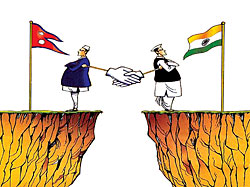 |
This is the time-honoured tradition in Nepal. There is no way Nepal can gain something from India without giving something away. And given our trade deficit and our overwhelming dependence, there will always be a pound of flesh. But gone are the days of grand gestures and magnanimity, reciprocity is now the mainstay of diplomacy even in asymmetrical bilateral relations.
This is not new, the Sugauli Treaty severely curtailed the elbow room of Nepali rulers after the Anglo-Nepal wars of 1814-16. By personally leading the military contingent to assist besieged British troops in Lucknow during Sepoy Mutiny in 1857, Jung Bahadur proved that he led a vassal state.
In recognition of Nepal's assistance during World War I (1914-18) the British elevated their minister in the court of Kathmandu to the level of envoy. But Nepal remained more or less a tributary state. It was called once again to contribute to the Allied war effort in World War II (1939-45), but the country failed to benefit in any tangible way. Profits of victory accrued to the Rana rulers and their families.
The departure of the British from the subcontinent in 1947 was followed by the replacement of the Ranas by the Shahs in Nepal. But the basic nature of Indo-Nepal relationship remained almost the same. In lieu of Jawaharlal Nehru's help in reinstalling him to the Serpent Throne, King Tribhuvan accepted the patron-client relationship enshrined in the Indo-Nepal Treaty of 1950. The overlord had extracted its tribute from the ruler of the protectorate.
There was a brief 18-months interregnum of some semblance of independence in foreign policy during the premiership of BP Koirala. But King Mahendra ended it in December 1960 with a military coup and to consolidate his absolutism, he agreed to abide by all terms set by Delhi. But when the Cold War increased the number of strategic suitors in Kathmandu, and following the Indo-China War in 1962, Mahendra tried to play it both ways, arousing India's suspicions.
Nepal's diplomatic flirtations soon came to an end with the fall of the Soviet Union and the sudden US dis-engagement in South Asia. When Indians imposed an economic blockade on landlocked Nepal in 1989, no country, not even our northern neighbour, considered it worth their while to come to the rescue. Once limits of Nepal's sovereignty were starkly exposed, every successive government in Kathmandu resigned itself to the inherent asymmetry in Indo-nepal relations.
The 12-point agreement between Maoists and the mainstream parties signed in Delhi in November 2006 set the stage for the fall of the Shah monarchy.
Pushpa Kamal Dahal can rave and rant as much as he wants against bideshi prabhuharu but all his outbursts against foreign overlords are not going to change the ground reality: no Nepali prime minister can survive in Singh Darbar for long by alienating South Block.
In the coming days, Nepal will have to learn to cope with fundamental changes in the outlook of the Indian establishment. Indian foreign policy is a legacy of the imperial Brits and with the signing of Indo-US civilian nuclear deal, New Delhi has adopted the bazaar model of diplomacy. There is no place for emotions in the marketplace.
It's pointless to talk about age-old linkages of shared culture or of the sacrifices made by Gorkha soldiers to protect the unity and integrity of the Indian Union. Compassion doesn't come into market relationships, all transactions are based on the principle of Caveat Emptor: without a warranty the buyer assumes the risk of quality.
READ ALSO:
Nepal's Mr Nepal - FROM ISSUE #465 (21 AUG 2009 - 27 AUG 2009)



